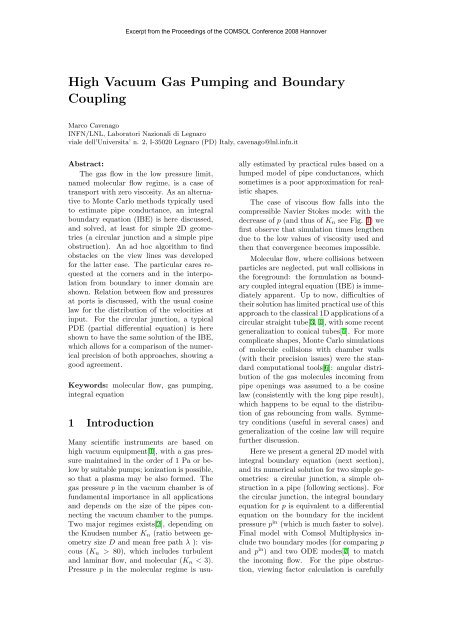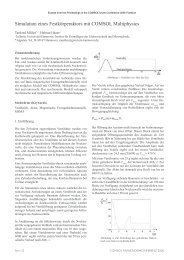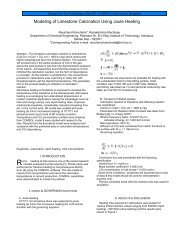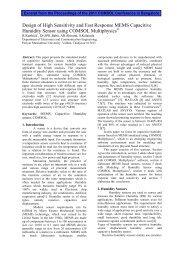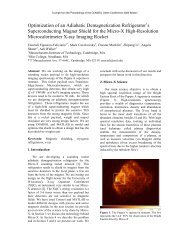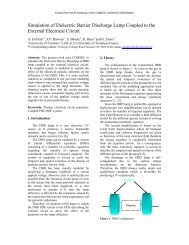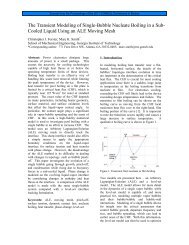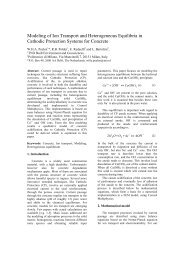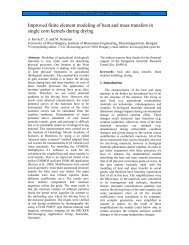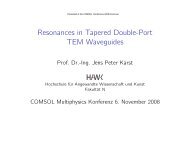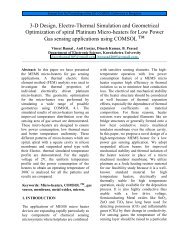High Vacuum Gas Pumping and Boundary Coupling - COMSOL.com
High Vacuum Gas Pumping and Boundary Coupling - COMSOL.com
High Vacuum Gas Pumping and Boundary Coupling - COMSOL.com
You also want an ePaper? Increase the reach of your titles
YUMPU automatically turns print PDFs into web optimized ePapers that Google loves.
<strong>High</strong> <strong>Vacuum</strong> <strong>Gas</strong> <strong>Pumping</strong> <strong>and</strong> <strong>Boundary</strong><br />
<strong>Coupling</strong><br />
Marco Cavenago<br />
INFN/LNL, Laboratori Nazionali di Legnaro<br />
viale dell’Universita’ n. 2, I-35020 Legnaro (PD) Italy, cavenago@lnl.infn.it<br />
Abstract:<br />
The gas flow in the low pressure limit,<br />
named molecular flow regime, is a case of<br />
transport with zero viscosity. As an alternative<br />
to Monte Carlo methods typically used<br />
to estimate pipe conductance, an integral<br />
boundary equation (IBE) is here discussed,<br />
<strong>and</strong> solved, at least for simple 2D geometries<br />
(a circular junction <strong>and</strong> a simple pipe<br />
obstruction). An ad hoc algorithm to find<br />
obstacles on the view lines was developed<br />
for the latter case. The particular cares requested<br />
at the corners <strong>and</strong> in the interpolation<br />
from boundary to inner domain are<br />
shown. Relation between flow <strong>and</strong> pressures<br />
at ports is discussed, with the usual cosine<br />
law for the distribution of the velocities at<br />
input. For the circular junction, a typical<br />
PDE (partial differential equation) is here<br />
shown to have the same solution of the IBE,<br />
which allows for a <strong>com</strong>parison of the numerical<br />
precision of both approaches, showing a<br />
good agreement.<br />
Keywords: molecular flow, gas pumping,<br />
integral equation<br />
1 Introduction<br />
Excerpt from the Proceedings of the <strong>COMSOL</strong> Conference 2008 Hannover<br />
Many scientific instruments are based on<br />
high vacuum equipment[1], with a gas pressure<br />
maintained in the order of 1 Pa or below<br />
by suitable pumps; ionization is possible,<br />
so that a plasma may be also formed. The<br />
gas pressure p in the vacuum chamber is of<br />
fundamental importance in all applications<br />
<strong>and</strong> depends on the size of the pipes connecting<br />
the vacuum chamber to the pumps.<br />
Two major regimes exists[2], depending on<br />
the Knudsen number Kn (ratio between geometry<br />
size D <strong>and</strong> mean free path λ ): viscous<br />
(Kn > 80), which includes turbulent<br />
<strong>and</strong> laminar flow, <strong>and</strong> molecular (Kn < 3).<br />
Pressure p in the molecular regime is usu-<br />
ally estimated by practical rules based on a<br />
lumped model of pipe conductances, which<br />
sometimes is a poor approximation for realistic<br />
shapes.<br />
The case of viscous flow falls into the<br />
<strong>com</strong>pressible Navier Stokes mode: with the<br />
decrease of p (<strong>and</strong> thus of Kn see Fig. 1) we<br />
first observe that simulation times lengthen<br />
due to the low values of viscosity used <strong>and</strong><br />
then that convergence be<strong>com</strong>es impossible.<br />
Molecular flow, where collisions between<br />
particles are neglected, put wall collisions in<br />
the foreground: the formulation as boundary<br />
coupled integral equation (IBE) is immediately<br />
apparent. Up to now, difficulties of<br />
their solution has limited practical use of this<br />
approach to the classical 1D applications of a<br />
circular straight tube[3, 4], with some recent<br />
generalization to conical tubes[5]. For more<br />
<strong>com</strong>plicate shapes, Monte Carlo simulations<br />
of molecule collisions with chamber walls<br />
(with their precision issues) were the st<strong>and</strong>ard<br />
<strong>com</strong>putational tools[6]: angular distribution<br />
of the gas molecules in<strong>com</strong>ing from<br />
pipe openings was assumed to a be cosine<br />
law (consistently with the long pipe result),<br />
which happens to be equal to the distribution<br />
of gas rebouncing from walls. Symmetry<br />
conditions (useful in several cases) <strong>and</strong><br />
generalization of the cosine law will require<br />
further discussion.<br />
Here we present a general 2D model with<br />
integral boundary equation (next section),<br />
<strong>and</strong> its numerical solution for two simple geometries:<br />
a circular junction, a simple obstruction<br />
in a pipe (following sections). For<br />
the circular junction, the integral boundary<br />
equation for p is equivalent to a differential<br />
equation on the boundary for the incident<br />
pressure p in (which is much faster to solve).<br />
Final model with Comsol Multiphysics include<br />
two boundary modes (for <strong>com</strong>paring p<br />
<strong>and</strong> p in ) <strong>and</strong> two ODE modes[7] to match<br />
the in<strong>com</strong>ing flow. For the pipe obstruction,<br />
viewing factor calculation is carefully
optimized with some scripting. Remarks on<br />
the generalization to 3D are discussed in the<br />
conclusion.<br />
Figure 1: Sketch of viscosity (arbitrary units),<br />
Reynolds number Re <strong>and</strong> Knudsen number Kn<br />
vs pressure p<br />
2 Molecular flow<br />
The well known ideal gas law p = nkBT relates<br />
the isotropic pressure of a gas to the<br />
number density of molecules n <strong>and</strong> to the<br />
temperature T , so that the mean free path<br />
λ =<br />
1<br />
√ 2 nσ = kBT<br />
√ 2pσ<br />
(1)<br />
is inversely proportional to the pressure;<br />
here σ is the cross section of elastic collision<br />
between molecules of mass m. The mass<br />
density is ρ = n m = p m/kBT .<br />
Figure 2: A generic planar geometry (if a<br />
septum exists, this is excluded from the<br />
simulation domain D). The point B is the<br />
running integration point, while A is the<br />
so-called destination or observation point<br />
The average value of the modulus of the<br />
velocity vav = (8kBT/πm) 1/2 is of course<br />
different from the fluid velocity vf , which is<br />
the average of velocities; roughly |vf | ≤ vav.<br />
When λ ≪ D, where D is a typical diameter<br />
of our pipe, the gas moves as a fluid,<br />
according to the <strong>com</strong>pressible Navier Stokes<br />
equations (since mass density is proportional<br />
to pressure), with a fluid velocity vf <strong>and</strong> a<br />
viscosity<br />
η = c3ρλvav = 2 −1/2 c3mvav/σ (2)<br />
here c3 = 0.499 according to detailed transport<br />
calculation [8]; note η is indipendent<br />
from p in this regime.<br />
When λ ≥ D/3, the pipe wall perturb<br />
most of the gas motion, so that λ must be<br />
replaced by c4D in equation (2), with the<br />
estimate c4 ∼ = 0.5. Viscosity has to decrease<br />
with pressure p → 0 . Figure 1 shows a<br />
sketch of the dependence from p of η <strong>and</strong><br />
of the well known Reynolds number Re =<br />
ρ vf D/η, which has the limit vf /c3c4vav ∼ = 1<br />
for p → 0.<br />
Let us restrict to a 2D planar geometry<br />
as in Fig 2, where the simulation domain D<br />
(closed, but necessarily simply connected or<br />
convex) has solid walls <strong>and</strong> pipe openings<br />
(Fig 3) as boundaries; for simplicity we will<br />
not here discuss periodicity <strong>and</strong>/or symmetric<br />
boundary conditions. At equilibrium, the<br />
(numeric) flow density F in of particles incident<br />
onto a wall<br />
F in = nvav/4 = p in /(2πmkBT ) (3)<br />
is related to the pressure p in incident on the<br />
wall; in the following we will convert flows<br />
to pressures by this proportion.<br />
Figure 3: The example of a circular junction<br />
At any point B on a solid wall, we assume<br />
that the reemitted numeric flow F re<br />
is equal to F in , <strong>and</strong> particle angular distibution<br />
is f(ϑB) = 1<br />
2 cos ϑB where ϑB is the<br />
angle from the inward normal nB to the particle<br />
direction (Fig 2). Let F vo the net volumetric<br />
flow density (measured in [Pa m/s])<br />
which enters from an opening; we assume<br />
that the flow reeemitted F re is equal to F in
Figure 4: Elevation plot of simulation result for<br />
p re <strong>and</strong> p in with p0 = f1 = 1 mPa<br />
with the shorth<strong>and</strong> F ins = 4F vo /vav are the<br />
basic relation of particle conservation. plus<br />
the entering flow F vo /kBT . The equivalent<br />
equations<br />
F vo<br />
kBT +F in <strong>and</strong> p re = F ins +p in (4)<br />
Noting that any particle reemitted from<br />
F re =<br />
point B will incide at a point A, making an<br />
angle ϑA with the inward normal nA, the<br />
incident pressure is<br />
p in A = L[p re <br />
] = dsB<br />
cos ϑB cos ϑA<br />
p<br />
2ϱ<br />
re<br />
BIAB<br />
(5)<br />
where the chord ϱ = xB − xA is the vector<br />
from A to B <strong>and</strong> IAB is the viewing indicatrix:<br />
equal to one if line segment AB is<br />
not obstructed (by walls), otherwise equal<br />
to zero. In particular, IAB = 0 if cos ϑB < 0<br />
or if cos ϑA < 0, since these cases corrispond<br />
to a chord passing into the walls.<br />
Equations (4) <strong>and</strong> (5) are a formulation<br />
of our problem with integral boundary equation<br />
(IBE) only; references the pressure<br />
Figure 5: Simulation results: contour <strong>and</strong><br />
surface plot of p i (note the r < 0.98r0 mask) ;<br />
Here p3 = 2 mPa <strong>and</strong> p1 = 0.5 mPa, with the<br />
result f1 = 0.825 mPa <strong>and</strong> p0 = 1.25 mPa<br />
inside D is not necessary; anyway for postprocessing<br />
we define the inner (or isotropic)<br />
pressure at an inner point A as<br />
p i A = M[p re <br />
] = dsB<br />
cos ϑB<br />
2πϱ pre<br />
B IAB (6)<br />
this can be justified by balancing the in <strong>and</strong><br />
out flows on a circle of radius ɛ ∼ = h centered<br />
at A, where h is the mesh element size; so<br />
that eq. (6) holds strictly when distance wA<br />
of A from walls is large enough:<br />
wA ≡ min<br />
B ϱ ≥ h(A) (7)<br />
3 The circular junction<br />
In the geometry of Fig 3, the simulation domain<br />
D is the circle r ≤ r0; let (ψ, r) be the<br />
polar coordinates <strong>and</strong> the output port P1 be<br />
around ψ = 0, while gas may enter from the<br />
other three ports. All points of the boundary<br />
γ see each other, so IAB = 1; moreover<br />
cos ϑB = sin(|ψA − ψB|/2) from simple geometry,<br />
so that L simplifies to<br />
L[p re ] = 1<br />
π<br />
4 dψB p<br />
−π<br />
re<br />
B sin( 1<br />
2 |ψA − ψB|) (8)<br />
The expression (8) is directly implemented<br />
as boundary integration variable<br />
(’elle’) in Comsol Multiphysics, with destination<br />
domain the boundary γ itself (here<br />
ψA is the destination coordinate). The<br />
boundary weak term looks like<br />
bnd.expr=’test(p)*(elle+fins-p)’<br />
Figure 6: Simulation results on the lower<br />
boundary: p re as <strong>com</strong>puted from the IBE eq<br />
(8); p re from eq. (4), with p in <strong>com</strong>puted from<br />
the PDE equation (10).
Figure 7: a) The simple obstruction, with a IAB = 0 ray in red; b) a detail of a corner<br />
where the p re variable is typed ’p’. A first example<br />
of solution for the case F ins = f1 = 1<br />
mPa (millipascal) on port 3 (near ψ = −π)<br />
<strong>and</strong> Fins = −f1 on port 1 is shown in figure<br />
4. Ports 2 <strong>and</strong> 4 are here unused <strong>and</strong> we<br />
set the pressure reference value p re = p0 = 1<br />
mPa at ψ = −π/2.<br />
It should be observed that the input pressure<br />
p3 <strong>and</strong> exit pressure p1 are usually<br />
given, while f1 is the quantity to be <strong>com</strong>puted.<br />
We thus add two ODE variables<br />
f1 <strong>and</strong> p0 to the multiphysics model; the<br />
two ODE equations are a linear <strong>com</strong>binations<br />
of the conditions p re (−π) = p3 <strong>and</strong><br />
p re (ψ = 0) = p1. As another improvement,<br />
we specify a flow F ins = −f1 cos ψ (on port 1<br />
<strong>and</strong> 3) to better represent an uniform input<br />
flow in the x direction <strong>and</strong> its projection on<br />
the curved boundaries P1 <strong>and</strong> P3.<br />
The surface plot of p i of fig 5 reveals a<br />
good accuracy for r/r0 < 0.98, with values<br />
showing that p i does not have p re as a limit<br />
value. To see reason of it, let us use a Fourier<br />
expansion<br />
p re = p0 + <br />
[p re m cos(mψ)<br />
+<br />
m=1<br />
p s m sin(mψ)] (r/r0) m (9)<br />
(the sin part is missing in our example, since<br />
we choose to use ports P1 <strong>and</strong> P3 only).<br />
We numerically note that M(1) = 1 <strong>and</strong><br />
M(r m cos mψ) = 1<br />
2 rm cos mψ (<strong>and</strong> similarly<br />
for the sin part). This shows: 1) △p i = 0<br />
<strong>and</strong> 2) the limit of p i is p0 + 1<br />
2 (pre − p0).<br />
These facts are related to the Cauchy integral<br />
formula.<br />
Generalization of these concepts to speed<br />
up <strong>com</strong>putation in a generic geometry is<br />
being investigated, but another interesting<br />
equivalence should be noted for the circular<br />
junction (only). Since<br />
L[cos(mψ)] = cos(mψ)/(1 − 4m 2 )<br />
(as we verified numerically for m =<br />
0, 1, .., 4), transforming equations (4) <strong>and</strong> (8)<br />
in Fourier cosine <strong>com</strong>ponents, we get<br />
− 4m 2 p in m = F ins<br />
m ⇔ ∂2pin ins<br />
= F<br />
∂ψ2 (10)<br />
which can be easily implemented into a PDE<br />
weak boundary mode. To <strong>com</strong>pare with<br />
previos example the the end conditions are<br />
pin (−π) = p3−f1 <strong>and</strong> pin (0) = p3+f1. Solution<br />
of equations (8) <strong>and</strong> (10) are <strong>com</strong>pared<br />
in Fig 6 <strong>and</strong> they perfectly match. Equation<br />
(10) shows also that integral of F ins is zero.<br />
Note that p0 assumes the value 1<br />
2 (p1 + p3)<br />
in the result, that is the average pressure in<br />
the domain.<br />
4 The simple obstruction<br />
The simple obstruction model shown in Fig<br />
7 has two ports, input P2 is the line segment<br />
x = 0, 0 ≤ x < Ly = 8 mm <strong>and</strong> exit P1 is<br />
at x = Lx = 1.6 cm. In this example we<br />
specify directly that the pressure p re (0, y) is<br />
a constant p2 at P2, instead of assuming an<br />
uniform flow (presence of the obstruction is<br />
expected to produced non uniformity both<br />
of F ins <strong>and</strong> of p in ).<br />
A new features is the presence of straight<br />
lines <strong>and</strong> of corners. Note the possible 1/ϱ<br />
singularity in the integr<strong>and</strong> of the eq (5)<br />
when B → A. In the case A <strong>and</strong> B stay<br />
on the
Figure 8: The stiffness matrix (full model has<br />
314 nodes, but a 157 node model is shown<br />
here. Note linear Lagrange element were used<br />
for hystorical reason, <strong>and</strong> that port nodes<br />
(where p re is given) are excluded from the<br />
shown stiffness matrix<br />
same line segment, cos θA = cos θB = 0,<br />
so that this whole segment can be excluded<br />
from integration on B; this explains the gaps<br />
in the stiffness matrix of the problem shown<br />
in fig 8. In the case A <strong>and</strong> B stay on the<br />
same arc with curvature k (as in the previous<br />
circle example), we get cos θA ∼ = cos θB =<br />
0 ∼ = 1<br />
2kϱ, which cancel the singularity, leaving<br />
an integr<strong>and</strong> ∝ ϱ. When A is at a fixed<br />
distance rA near a corner C (with an angle<br />
β < π) <strong>and</strong> B moves on the other side of<br />
the corner, rapid variations of the integr<strong>and</strong><br />
are observed. In lack of an absolutely certain<br />
formula (see appendix) to correct for<br />
the possible discontinuity of the integral (5)<br />
when A is within one mesh size from a corner<br />
C, it is advisable to refine the mesh as<br />
much as possible at corners.<br />
In the case of angles β > π the contribution<br />
of regions near the corner to the integral<br />
is zero (since the viewing factor is zero).<br />
Figure 9: Elevation plot of simulation result for<br />
p re <strong>and</strong> p in with p2 = 0.3 Pa <strong>and</strong> p1 = 50 mPa<br />
Conservatively we refine the mesh also at<br />
these corners, since they happen to be near<br />
to the obstruction region.<br />
The <strong>com</strong>putation of the viewing factor<br />
IAB is the most consuming task of the whole<br />
<strong>com</strong>putation, especially when surface plots<br />
of p i are generated in the postprocessing. To<br />
speed up it, we observed that a ray from A<br />
to B can be stopped only by the small rectangle<br />
R2, see fig 7, since the big rectangle<br />
R0 is convex. Computing the intersection of<br />
the ray AB with the sides of R2 is fast, since<br />
they are parellel to x or y: before calling<br />
the ’femstatic’ solver a table is prepared,<br />
where the data for the rules to <strong>com</strong>pute the<br />
intersections are stored, as a function of the<br />
indices of edges to which A <strong>and</strong> B belong.<br />
An elevation view of reemitted pressure<br />
p re is plotted in fig 9. Note the small spikes<br />
at the β = π/2 corners, as anticipated. We<br />
observe that their effects on the whole solution<br />
is very small (except near the corners),<br />
since the coupling is only via the integral (5).<br />
The large jump at the input <strong>and</strong> output port<br />
is not an error, but is to satisfy the boundary<br />
condition. Moreover, thanks to eq (4),<br />
the net flow density (in rescaled units) in the<br />
x-direction is p2 − p in at port 2 (input) <strong>and</strong><br />
p in −p1 at port P1 (exit); these are <strong>com</strong>pared<br />
in figure 10.<br />
A steep descent <strong>and</strong> a step of p re are visible<br />
at the β = 3π/2 corners, in perfect analogy<br />
with the possible differences of illumination<br />
on two adjacent sides of a pilaster,<br />
as later explained. The elevation plot of p i<br />
shown in fig 11 is smooth in the region given<br />
by equation (7).<br />
Figure 10: Input <strong>and</strong> exit flow density F ins<br />
(here rescaled in Pa, to obtain the volumetric<br />
flow density F ins multiply by vav/4 = 120 m/s<br />
for nitrogen at T = 300 K); note that flow is<br />
still non-uniform due the obstuction
5 Conclusion <strong>and</strong><br />
perspectives<br />
The possibility to solve integral equation on<br />
boundary with finite elements methods allowed<br />
us to find the gas densities <strong>and</strong> flows<br />
in the molecular regime (a classical problem<br />
of physics <strong>and</strong> of technology), which great<br />
precision (as <strong>com</strong>pared to usual Monte Carlo<br />
methods) almost everywhere in the solution<br />
domain. Implementation of integral equations<br />
in Comsol Multiphysics was seamless[7]<br />
<strong>and</strong> post-processing helped insight of elaborate<br />
mathematical objects. Since the ruling<br />
equation is not in the form of a partial differential<br />
equation (PDE), solution may include<br />
discontinuous features (especially at corners<br />
<strong>and</strong> borders of the domain). In general, in<br />
order to discriminate numerical noise from<br />
physical features, localized mesh refinements<br />
seem very effective. Simple techniques to<br />
speed up the viewing factor calculation were<br />
used.<br />
In a simplified case, the ruling equation<br />
was found equivalent to a PDE, which allows<br />
for a very satisfying test of the solution precision.<br />
This line of investigation is worth of<br />
future investigations.<br />
Among other works in progress, we are<br />
considering the possibility of openings where<br />
the tangential flow of particles is significant,<br />
generalizing the cosine law into<br />
f(ϑ) = p re (B)( 1<br />
2 cos ϑ + c5 sin ϑ) (11)<br />
where c5 is a small constant.<br />
Generalization to elaborate 3D geometries<br />
may require improvements in the vieving<br />
factor calculation speed, but looks well<br />
possible, considering the similarity with<br />
the problem of surface illuminations in a<br />
room [9] <strong>and</strong> with the problem of high<br />
temperature radiative cooling[10]. These<br />
tasks can be helped by specialized radiosity<br />
algorithms[10], like the methods used in<br />
rendering a (texture mapped) scene. In the<br />
case of room illumination, wall reemission<br />
is smaller than incident light, so total input<br />
flow can be different from zero (<strong>and</strong> iterative<br />
solution methods naturally apply). In<br />
the case of radiative cooling, heat adsorbed<br />
of one surface can be reemitted from the<br />
other side. Use of PC graphical hardware<br />
for viewing factor calculation was sometimes<br />
suggested.<br />
In some large accelerators, we typically<br />
find regions where 3D molecular flow calculation<br />
applies <strong>and</strong> others where Navier<br />
Stokes equation applies (larger diameter<br />
<strong>and</strong>/or larger pressure): capability of merging<br />
both approach appears extremely important.<br />
Figure 11: A surface plot of inner pressure p i ;<br />
spikes near the boundaries are due to the 1/ϱ<br />
singularity, see eq (7)<br />
References<br />
[1] H. F. Dylla ”Development of ultrahigh<br />
<strong>and</strong> extreme high vacuum technology for<br />
physics research” J. Vac. Sci. Technol. A,<br />
21, S25 (2003)<br />
[2] B. Ferrario, Introduzione alla tecnologia<br />
del vuoto, (ed. A. Calcatelli), Patron editore,<br />
Bologna (1999)<br />
[3] P. Clausing ”The flow of highly rarefied<br />
gases through tubes of arbitrary length”<br />
J. Vac. Sci. Technol. A 8, 636 (1971)<br />
[4] D. J. Santeler, ”New concepts in molecular<br />
gas flow”, J. Vac. Sci. Technol. A, 4,<br />
338 (1986)<br />
[5] B. Mercier ”Conductance measurement<br />
of a conical tube <strong>and</strong> calculation of the<br />
pressure distribution” J. Vac. Sci. Technol.<br />
A 24, 529 (2006)<br />
[6] D. H. Davis ”Monte Carlo calculation of<br />
molecular flow rates through a cylindrical<br />
elbow <strong>and</strong> pipes of other shapes”, J.<br />
Appl. Phys. 31, 1169 (1960)<br />
[7] W. B. Zimmerman, Multiphysics modelling<br />
with finite element methods, Singapore,<br />
World Scientific, (2006).
[8] S. Chapman, Proc. Roy. Soc. London, A<br />
177, 38 (1940-11941)<br />
[9] C. Goral, K. E. Torrance, D. P. Greenberg<br />
<strong>and</strong> B. Battaile, ”Modeling the interaction<br />
of light between diffuse surfaces”,<br />
Computer Graphics, 18, 213<br />
(1984)<br />
[10] S. Mazumder, ”Methods to Accelerate<br />
Ray Tracing in the Monte Carlo Method<br />
for Surface-to-Surface Radiation Transport”,<br />
J. Heat Transfer, 128, 945 (2006)<br />
Appendix<br />
To <strong>com</strong>pute the contribution LC of the edge<br />
portion near a corner C to the eq (5), let us<br />
call Λ the proper cut-off on the sB integration<br />
variable (oriented as shown in fig 7.b)<br />
<strong>and</strong> note that cos ϑB = sA sin(β)/ϱ; simi-<br />
larly for ϑA. We get<br />
LC(β, sA, Λ) =<br />
Λ<br />
0<br />
dsBp re<br />
B<br />
sBsA(sin β) 2<br />
2ϱ 3<br />
(12)<br />
with ϱ = (s2 A + s2B − 2 sAsB cos β) 1/2 . Note<br />
that pre B ∼ = pre C suffices for a first estimate.<br />
A large overestimate is obtained by taking<br />
formally Λ → ∞ so that<br />
LC < LC(β, sA, ∞) = p re<br />
C g1(β) (13)<br />
with g1(β) = 1<br />
2 (1 + cos β) which proves that<br />
LC is bounded (at least, it is not infinite). A<br />
more strict estimate may <strong>com</strong>e from a simmetric<br />
corner cut-off sB ≤ sA which gives<br />
LC ∼ = LC(β, sA, sA) = p re<br />
C g(β) (14)<br />
with g(β) = 1<br />
2 (1 − sin(β/2)). This finite<br />
contribution is correctly estimated by the<br />
boundary integration when A = C; but<br />
when A = C a literal application of equation<br />
(5) or (12) gives LC = 0. We speculate<br />
that the inclusion (in future calculations) of<br />
a point contribution (as a point weak term )<br />
like equation (13) [or better (14)] may help<br />
precision in the case A = C (that is, at corners).


